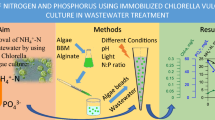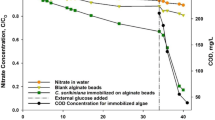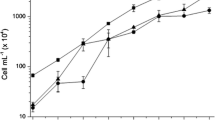Abstract
The potential of alginate-immobilized Anabaena doliolum and Chlorella vulgaris was assessed for removal of nutrients (NO sup-inf3 and NH sup+inf4 ) and metals (Cr2O sup2-inf7 and Ni2+) at different biomass concentrations (0.05, 0.1, 0.25, 0.49 and 1.22 g dry wt l-1) and pH values (4 to 10). Though uptake of all these substances was higher in concentrated algal beads (0.25, 0.49 and 1.22 g dry wt l-1), their rate of uptake was significantly (P<0.001) lower than that of low (0.05 g dry wt l-1) cell density beads. For A. doliolum, there was no significant difference in uptake rates for beads having densities of 0.05 and 0.1 g dry wt l-1. Chlorella vulgaris, however, showed maximum efficiency at 0.1 g dry wt l-1. Uptake of both the nutrients and the metals was maximal at pH 7 followed by pH 8, 6, 9, 10, 5 and 4. Of the different substances (organic acids and divalent cations) used, humic acid was most efficient in decreasing metal uptake. Mg2+ was, however, more efficient than Ca2+ in decreasing Ni2+ uptake. Immobilized algae with a cell density of 0.1 g dry wt l-1 were the most efficient for nutrient and metal removal at pH 6 to 8.
Similar content being viewed by others
References
Abeliovich, A. 1980 Factors limiting algal growth in high rate oxidation ponds. In Algal Biomass, eds Shelef, G. & Soeder, C.J. pp. 205–372. Amsterdam: Elsevier/North Holland Biomedical.
Ali, M. & Deo, N. 1991 Effect of pH on adsorption process of chromium (vi) with a new low cost adsorbant. Indian Journal of Environmental Protection 12, 202–209.
Allen, M.B. & Arnon, D.I. 1955 Studies on nitrogen-fixing blue green algae. I. Growth and nitrogen fixation by Anabaena cylindrica Lemm. Plant Physiology 30, 366–372.
Babich, H. & Stotzky, G. 1986 Environmental factors affecting the utility of microbial assays for the toxicity and mutagenicity of chemical pollutants. In Toxicity Testing using Microorganisms, eds Dutka, B.J. & Bitton, G. pp. 9–42. Boca Raton, FL: CRC Press.
Bajpai, P.K., Wallace, J.B. & Margaritis, A. 1985 Effect of calcium chloride concentration on ethanol production and growth of immobilized Zymomonas mobilis. Journal of Fermentation Technology 63, 199–203.
Borgmann, U. 1983 Metal speciation and toxicity of free ions to aquatic biota. In Aquatic Toxicology, ed Nriagu, J.O. pp. 47–72. New York: John Wiley and Sons.
Bozeman, J., Koopman, B. & Bitton, G. 1989 Toxicity testing using immobilized algae. Aquatic Toxicology 14, 345–352.
Chevalier, P. & De laNoüe, J. 1985 Wastewater nutrient removal with microalgae immobilized in carrageenan. Enzyme and Microbial Technology 7, 621–624.
Costa, A.C.da & Gomez, S.G.F. 1991 Metal biosorption by sodium alginate immobilized Chlorella homosphaera cells. Biotechnology Letters 13, 559–562.
Darnall, D.W., Greene, B., Benzl, M.T., Hosea, J.M., McPherson, R.A., Snedden, J. & Alexander, M.D. 1986 Selective recovery of gold and other metal ions from an algal biomass. Environmental Science and Technology 20, 206–208.
De la Noüe, J. 1983 Hyperintensive wastewater tertiary treatment by floculated activated algal sludge. In Proceedings of International Conference on the Commercial Applications and Implications of Biotechnology, London, UK, pp. 1005–1015. London.
Gerloff, G.C., Fitzgerald, G.P. & Skoog, F. 1950 The isolation, purification and culture of blue-green algae. American Journal of Botany 37, 216–218.
Herbert, D., Phipps, P.J. & Strange, R.E. 1971 Chemical analysis of microbial cells. In Methods in Microbiology, Vol. 5B, eds Norris, J.R. & Ribbons, D.W. pp. 209–344. London: Academic Press.
Hongve, D., Skogheim, O.K., Hindar, A. & Abrahamsen, H. 1980 Effects of heavy metals in combination with NTA, humic acid and suspended sediment on natural phytoplankton photosynthesis. Bulletin of Environmental Contamination and Toxicology 25, 594–600.
Hughes, M.N. & Poole, R.K. 1989 Metal mimicry and metal limitation in studies of metal-microbe interactions. In Metal-Microbe Interactions, eds Poole, R.K. & Gadd, G.M. pp. 1–18. New York: IRL Press.
Lakhawala, F.S., Lodaya, M.P. & Yang, C. 1989 Design of toxic waste treatment bioreactor: viability studies of microorganisms entrapped in alginate gel. In International Conference on Physiochemical and Biochemical Detoxification of Hazardous Wastes, Vol. 1, ed Wu, Y.C. pp. 587–599. Technomic Publishing.
Lavoie, A. & De laNoüe, J. 1983 Harvesting microalgae with chitosan. Journal of the World Marculture Society 14, 685–694.
Levine, I.N. 1988 Transport process. In Physical Chemistry, ed Levine, I.N. pp. 467–505. Singapore: McGraw Hill.
Martin, J.H. 1979 Bioaccumulation of heavy metals by littoral and pelagic marine organisms. US Environmental Protection Agency Report No. 600/3-77-038.
Nicholas, D.J. & Nason, A. 1957 Determination of nitrate and nitrite. Methods in Enzymology 3, 981–984.
Oelmuller, R., Schuskr, C. & Mohr, H. 1988 Physiological characterization of a astirdic signal required for nitrate and nitrite reductase. Planta 174, 75–83.
Rai, L.C., Dubey, S.K. & Mallick, N. 1992 Influence of chromium on some physiological variables of Anabaena doliolum. Interaction with metabolic inhibitors. Biometals 5, 13–16.
Rai, L.C. & Mallick, N. 1992 Removal and assessment of toxicity of Cu and Fe to Anabaena doliolum and Chlorella vulgaris using free and immobilized cells. World Journal of Microbiology and Biotechnology 8, 110–114.
Rai, L.C. & Raizada, M. 1986 Nickel-induced stimulation of growth, heterocyst differentiation 14CO2 uptake and nitrogenase activity in Nostoc muscorum. New Phytologist 104, 111–114.
Robinson, P.K., Dainty, A.L., Goulding, K.H., Simpkin, I. & Trevan, M.D. 1985 Physiology of alginate immobilized Chlorella. Enzyme and Microbial Technology 7, 212–216.
Schecher, W.D. & Driscoll, C.T. 1985 Interaction of copper and lead with Nostoc muscorum. Water, Air and Soil Pollution 24, 85–101.
Singh, S.P., Verma, S.K., Singh, R.K. & Pandey, P.K. 1989 Copper uptake by free and immobilized cyanobacterium. FEMS Microbiology Letters 60, 193–196.
Stokes, P.M. 1983 Responses of fresh water algae to metals. Progress in Phycological Research 2, 87–109.
Author information
Authors and Affiliations
Rights and permissions
About this article
Cite this article
Mallick, N., Rai, L.C. Influence of culture density, pH, organic acids and divalent cations on the removal of nutrients and metals by immobilized Anabaena doliolum and Chlorella vulgaris . World J Microbiol Biotechnol 9, 196–201 (1993). https://doi.org/10.1007/BF00327836
Revised:
Accepted:
Issue Date:
DOI: https://doi.org/10.1007/BF00327836




